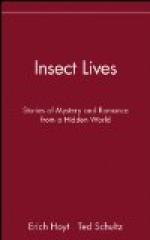Beetles are as a rule remarkable among insects for the firm consistency of their chitinous cuticle, the various pieces (sclerites) of which are fitted together with admirable precision. In some families of beetles the larva also is furnished with a complete chitinous armour, the sclerites, both dorsal and ventral, of the successive body-segments being hard and firm, while the relatively long legs possess well-defined segments and are often spiny. Such a larva is evidently far less unlike its parent beetle than a caterpillar is unlike a butterfly. Perhaps of all beetle larvae, the woodlouse-like grub (fig. 12 b) of a carrion-beetle (Silpha) or of a semi-aquatic dascillid such as Helodes shows the least amount of difference from the typical adult, on account of the conspicuous jointed feelers. The larval glow-worm, however, is of the same woodlouse-like aspect, and in this case, where the female never acquires wings, but becomes mature in a form which does not differ markedly from that of the larva, the exceptional resemblance is closer still. In all beetle-grubs the legs are simplified, there being only one segment (a combined shin and foot) below the knee-joint, whereas in the adult there is a shin followed by five, four, or at least three distinct tarsal segments. The foot of an adult beetle bears two claws at its tip, while the larval foot in the great majority of families has only one claw. In one section of the order, however, the Adephaga comprising the predaceous terrestrial and aquatic beetles, the larval foot has, like that of the adult, two claws. Some adephagous larvae, notably those of the large carnivorous water-beetles (Dyticus), often destructive to tadpoles and young fish, have completely armoured bodies as well as long jointed legs. More commonly, as with most of the well-known Ground-beetles (Carabidae), the cuticle is less consistently hard, firm sclerites segmentally arranged alternating with considerable tracts of cuticle which remain feebly chitinised and flexible. Most of the adephagous larvae (fig. 13) have a pair of stiff processes on the ninth abdominal segment, and the insect, from its general likeness to a bristle-tail of the genus Campodea, is often called a campodeiform larva (Brauer, 1869). From such as these, a series of forms can be traced among larvae of beetles, showing an increasing divergence from the imago. The well-known wireworms—grubs of the Click-beetles (Elateridae)—that eat the roots of farm crops, have well-armoured bodies, but their shape is elongate, cylindrical, worm-like; and their legs are relatively short, the build of the insect being adapted for rapid motion through the soil. The grubs of the Chafers (Scarabaeidae) are also root-eaters, but they are less active in their habits than the wireworms, and the cuticle of their somewhat stout bodies is, for the most part, pale and flexible; only the head and legs are hard and horny. Usually an evident correspondence can be traced between the




